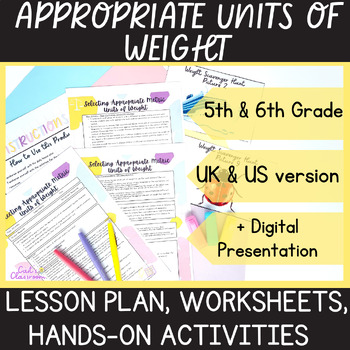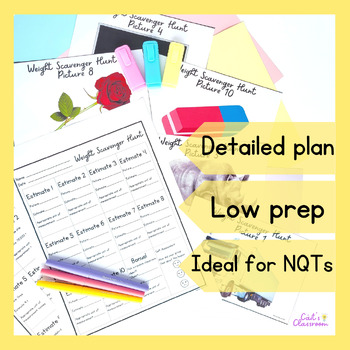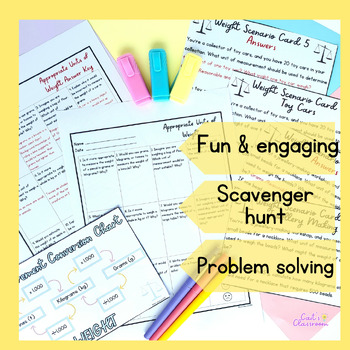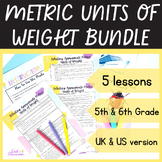Appropriate Units of Weight│Lesson Plan, Problems, Worksheet│5th/6th Grade Math
- Zip
Also included in
- Preparing to teach metric units of weight measured in tons, kilograms and grams? Looking for step-by-step lesson plans, hands-on measurement activities, digital presentations, engaging games and practice worksheets? Then this resource is for ✨️YOU!✨️Designed specifically with newly qualified teachersPrice $13.95Original Price $19.93Save $5.98
- 5th/6th grade end of year math fun! Preparing to teach metric weight and capacity? From liters and milliliters to tons and kilograms, this unit features hands-on measurement games/activities, digital/printable resources and detailed lesson plans.Designed specifically with newly qualified teachers inPrice $29.70Original Price $45.68Save $15.98
Description
Looking for a fun, engaging lesson for fifth/sixth grade on estimating appropriate metric units of weight? Want it to include worksheets, problems and hands-on activities for selecting, estimating, comparing and converting tons, kilograms and grams? Then this resource is for ✨️YOU!✨️
Take the stress out of creating complete lesson plans and resources! This lesson is aligned with both CCSSM and the Irish Primary Mathematics Curriculum (2023) and contains UK and US versions for appropriate spelling. ✏️
Help your students excel in math while reclaiming your valuable downtime with this engaging, curriculum-aligned lesson plan. Grab your copy TODAY!
⭐️Benefits⭐️
✅️ Reduces planning demands on teachers, saving valuable time and effort while being well-designed and aligned with curriculum standards.
✅️ Offers a complete, print-and-go resource with step-by-step instructions, ideal for newly qualified teachers who want support teaching math to the senior grades.
✅️ Enhances conceptual understanding and procedural fluency in selecting, comparing, estimating and converting metric units of weight for accurate communication and problem-solving.
⭐️In Depth Description⭐️
This 45-minute lesson plan includes:
✅ 10 Measurement Scavenger Hunt pictures: Engages students in an interactive activity that promotes active learning and reinforces their understanding of weight estimation.
✅ 1 Measurement Scavenger Hunt group worksheet and answer key: Facilitates collaborative learning as students work together to estimate appropriate units of weight.
✅ 6 real-life scenario cards: Presents students with practical applications of weight measurement concepts, fostering critical thinking and problem-solving skills..
✅ 1 individual worksheet and answer key: Provides students with opportunities for independent practice to reinforce their understanding of converting weight units.
✅ Conversion chart (color and black & white): Provides a reference tool for students to easily convert between different weight units, aiding in accuracy and comprehension.
✅️Math Talk digital presentation: Provides a clear focus for math discussions, encouraging student participation and collaboration.
✅️3 learning objectives: Clearly defines lesson outcomes, guiding both teachers and students in their learning goals.
✅️Differentiation strategies: Accommodates diverse learning needs, ensuring all students can access and succeed in the lesson.
✅️Assessment strategies: Provides practical guidance on assessing student understanding throughout the lesson.
✅️Key vocabulary and definitions: Equips students with essential language for effective communication about metric units of weight.
✅️Exit tickets (color and black & white): Quickly gauges student understanding at the end of the lesson, providing valuable feedback for future instruction.
✅️ Fully aligned with the new Irish Primary Mathematics Curriculum (2023), specifically the element of reasoning and the competencies of being an active citizen and being an active learner.
✅️Common Core aligned - CSS.MP.2, CSS.MP.3, CCSS.5.MD.A.1
⭐️Other Uses⭐️
1. Homework Extension: Extend the learning beyond the classroom by assigning the real-life scenario cards as homework. Students can apply their knowledge of selecting, estimating, comparing, and converting units of weight to solve practical problems at home. This reinforces their understanding of the concepts in a real-world context and encourages independent problem-solving skills.
2. Independent Practice and Review: Provide students with the individual worksheet and answer key for independent practice and review, allowing them to reinforce their understanding of estimating and converting metric units of weight through self-assessment and reflection.
3. Math Centers: Use the Math Talk digital presentation as a station in your math centers. Students can engage in focused discussions about weight measurement concepts, enhancing their understanding through peer interaction. This encourages collaborative learning and allows for differentiated instruction as students work through the presentation at their own pace.
➡️ Don't let this opportunity slip away! Elevate your teaching experience and engage your students - secure your complete lesson plan and resources TODAY! ⬅️
Click here to join the Cáit's Classroom mailing list for valuable tips, tricks, and special offers designed to support newly qualified teachers in effectively teaching math to 3rd-6th grade students.







